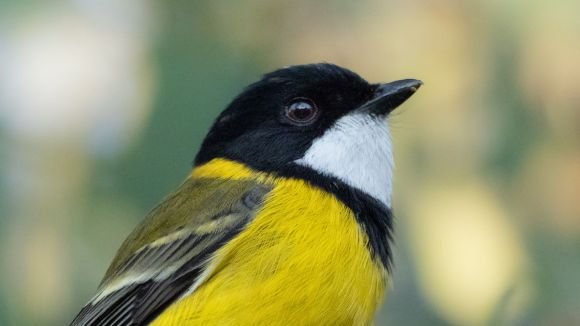“Whenever I’m lucky enough to see a Golden Whistler, it’s always because I’ve heard it first,” says Adi Tudor, a wildlife photographer who enjoys regular walks along Merri Creek. “They’ve got a very beautiful, melodic song. It always takes me by surprise, but it’s such a delight.”
Small insect-eating birds like Golden Whistlers have a preference for habitat where there is dense understorey and mid-storey shrubs to provide protection from larger, more territorial birds. While they are a relatively common species, and not under imminent threat, it’s unusual for them to be seen in the inner-north part of the Merri Creek. Golden Whistler (Pachycephala pectoralis), photograph by Adi Tudor
Golden Whistler (Pachycephala pectoralis), photograph by Adi Tudor
That’s why Adi, and her fellow photographer Gabrielle Pounsett, have been so excited by sightings of the Golden Whistler over the last few months. While females have an understated plumage of grey, with a pale-olive tinge, males have a distinctive bright-yellow chest, a yellow collar, and a broad, black band just below a white throat.
“When you’re walking in that wintery landscape, it’s wonderful to see the bright-golden male pop up,” says Adi. “It’s like a little bit of magic, and it brings me real joy to see something like that down on Merri Creek.”
As a long-term visitor to the creek, Adi has been able to observe changes over several years. She believes that recent planting work that was undertaken along the east bank around Thornbury could be what has started to attract the Golden Whistler to the area.
According to Chris Geary, Ecological Restoration Program Coordinator for Merri Creek Management Committee (MCMC), this is a plausible explanation, although it can be challenging to tie specific observations to such a recent project when the shrubs are still establishing.
“We got some grant funding in 2021 through Melbourne Water’s Corridors of Green program to work on revegetating a strip of the Merri Creek around Thornbury,” Chris explains. “There was a stretch of bank that had some tree canopy but it was lacking a dense mid-storey. It was just grass and weeds, no shrub layer at all. We focused on that area to improve habitat for the Pink Robin, but then obviously there’s a flow-on benefit for other small birds like the Golden Whistler too.”
As well as weed control and erosion reduction, the revegetation project involved planting 400 mid-storey shrubs, including Acacia paradoxa, a spikey mid-storey wattle; Correa glabra, a dense shrub with flowers that are highly attractive to honey-eaters; and Myoporum petiolatum, often referred to as Sticky Boobialla.
This on-ground work was led by Chris’s colleague Tony Bracey, a team leader with MCMC’s Ecological Restoration Program.
“Those spikier shrubs we’ve planted are great for small birds like Golden Whistlers to hide from territorial invasive birds like Noisy Miners,” Tony says. “That’s really important because if they’re getting harassed by miners and they’ve got nowhere to seek refuge they’ll just move somewhere else.”
The project began after members of the community, including Friends of Merri Creek, got in touch with us to share their observations of Pink and Rose Robins from the late 2010s. The birds were using shrubby vegetation near Strettle Lagoon (a few hundred metres upstream of the project site) and the Friends of Merri Creek encouraged us to plant more shrubby vegetation as habitat for these birds.
Quarterly bird surveys undertaken by Friends of Merri Creek provide valuable data for MCMC to explore the impacts of ecological restoration programs such as the one in Thornbury.
“The Friends of Merri Creek have been doing bird surveys there since 2008,” says Tony. “We’ve got 16 years of data, which is an incredibly useful resource. There’s been a very obvious increase in bird biodiversity. We’re seeing quite a few small birds in the area that haven’t been spotted so much, especially Pink Robins and Rose Robins, and there’s also a Sacred Kingfisher that comes through in October and has been spotted in the area.
“Birds are a great indicator,” adds Chris. “Because when you improve habitat structure they move in quite quickly, usually within three or four years.”
That’s good news for photographers like Adi, who love to capture images of the birds in the area. With a challenging job as a social worker, taking an evening or weekend stroll along Merri Creek – and keeping an eye out for her beloved Golden Whistler – is an unrivalled joy.
“My interest in the birds of the creek built up quite gradually, but now I’ve really fallen in love with them,” she says. “Carrying my camera around and capturing something of their beauty is a perfect way for me to have some downtime. There’s been so much planting done that’s contributed to wildlife coming back, and that enables me to have the wonderful experience I do on Merri Creek.”
In what Adi describes as her way of saying thank you for her experiences, she produces an annual Birds of Merri Creek Calendar, with half of the profits donated to the Merri Creek Environment Fund.
“For myself and some of my fellow bird watchers and artists on the creek, I think what we get from nature is it really fuels our creativity and imagination. There’s nothing much better than seeing the male Golden Whistler looking so beautiful amongst the wattle. He made it into the 2024 calendar though, so he might have to wait another year to two to be featured again.”
Story by Ruth Dawkins
Photograph by Adi Tudor.





 Merri Creek Management Committee. 2 Lee St, East Brunswick, Victoria, Australia 3057
Merri Creek Management Committee. 2 Lee St, East Brunswick, Victoria, Australia 3057